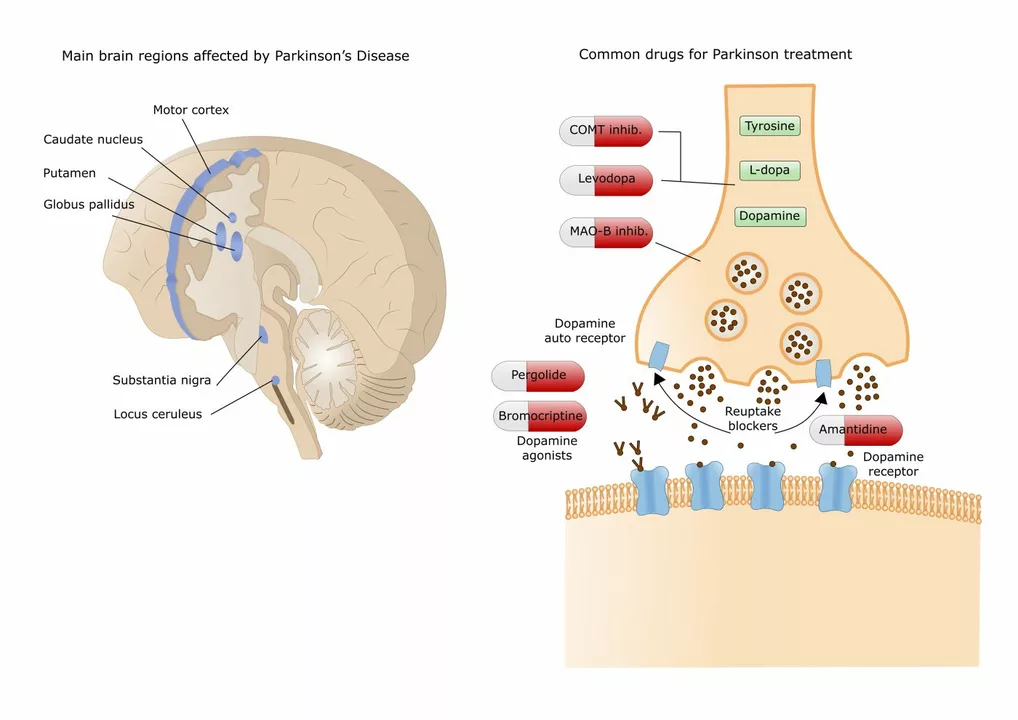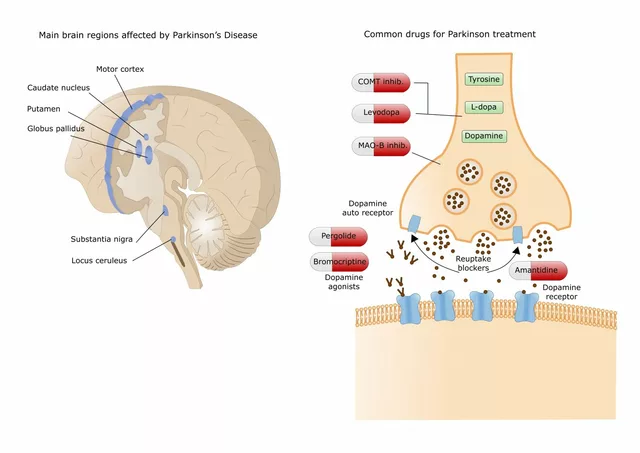Understanding Carbidopa-Levodopa Therapy
Before diving into the long-term effects of carbidopa-levodopa therapy, it's essential to understand what it is and why it's used. Carbidopa-levodopa is a medication commonly prescribed to treat Parkinson's disease, a neurodegenerative disorder that affects movement. Levodopa is converted into dopamine in the brain, which helps alleviate the symptoms of Parkinson's. Carbidopa, on the other hand, prevents levodopa from breaking down before it reaches the brain. In this section, we'll discuss the basics of this therapy and its role in treating Parkinson's disease.
Managing Motor Symptoms with Carbidopa-Levodopa
One of the primary benefits of carbidopa-levodopa therapy is its ability to manage the motor symptoms associated with Parkinson's disease. These symptoms typically include tremors, stiffness, and slowed movement. As the disease progresses, these motor symptoms can become more severe and have a significant impact on the patient's quality of life. In this section, we'll explore how carbidopa-levodopa therapy helps manage these motor symptoms and how it can improve the patient's overall well-being.
Carbidopa-Levodopa and Non-Motor Symptoms
While carbidopa-levodopa therapy is primarily known for its effectiveness in treating motor symptoms, it may also provide some benefits for non-motor symptoms of Parkinson's disease. These can include sleep disturbances, mood changes, and cognitive issues. In this section, we'll discuss the potential impact of carbidopa-levodopa therapy on these non-motor symptoms and whether it can improve the patient's overall quality of life.
The Onset of Motor Complications
Despite the many benefits of carbidopa-levodopa therapy, long-term use can lead to the development of motor complications. These can include "wearing off" episodes, in which the medication's effects diminish before the next dose is due, and involuntary movements known as dyskinesias. In this section, we'll delve into the potential onset of these motor complications and discuss strategies for managing them as part of a comprehensive treatment plan.
Addressing the Psychological Effects of Long-Term Therapy
Long-term carbidopa-levodopa therapy can also have psychological effects on patients with Parkinson's disease. For example, some patients may develop anxiety or depression as they grapple with the progressive nature of their condition and the limitations it imposes. In this section, we'll discuss the importance of addressing these psychological effects and explore how healthcare providers can support patients in managing their mental health.
Adjusting Carbidopa-Levodopa Dosage Over Time
As Parkinson's disease progresses, patients may require adjustments to their carbidopa-levodopa dosage to maintain optimal symptom control. This can be a complex process, as increasing the dosage may also increase the risk of motor complications. In this section, we'll discuss the factors that healthcare providers consider when adjusting carbidopa-levodopa dosage and the importance of regular monitoring to ensure the best possible treatment outcomes.
Considering Alternative and Adjunct Therapies
While carbidopa-levodopa therapy is a cornerstone of Parkinson's disease treatment, it may not be the only option for managing symptoms. In some cases, alternative or adjunct therapies may be necessary to provide optimal symptom control and improve the patient's quality of life. In this section, we'll explore some of these alternative therapies, such as deep brain stimulation and dopamine agonists, and discuss how they can complement carbidopa-levodopa therapy.
Maintaining Quality of Life in the Long Term
Ultimately, the goal of carbidopa-levodopa therapy and other Parkinson's disease treatments is to help patients maintain the best possible quality of life for as long as possible. In this final section, we'll discuss the importance of a comprehensive, multidisciplinary approach to Parkinson's disease management that addresses not only motor and non-motor symptoms but also the psychological and social aspects of living with a chronic, progressive condition.



Comments
Hey folks! I’m thrilled you’re digging into the nuances of carbidopa‑levodopa therapy. Think of it as a clever choreography between dopamine’s boost and the body’s own guardrails, letting many regain smoother movement. Yet, like any partnership, it can show wear over time- “wear‑off” phases and dyskinesias can sneak in. Staying proactive with dosage tweaks and complementary strategies can keep quality of life bright.
Everyone needs to ask who's really pulling the strings behind that shiny pill bottle 🚀. Big Pharma loves to keep us dependent, sprinkling just enough dopamine while hiding the long‑term shadows 🧠. They’ll tell you it’s the gold standard, but the same regimen seeds the very motor complications they market as “advanced disease”. Stay vigilant, question the narrative, and keep your mind open 👁️.
Honestly, the simplistic view that carbidopa‑levodopa is merely a miracle cure is utterly naive. The literature, if you actually read beyond the glossy abstracts, reveals a cascade of iatrogenic disturbances that most clinicians conveniently gloss over. There’s a moral imperative to expose these nuances, yet the mainstream persists in its comfortable delusion. It’s a disgrace how quickly the medical elite settle for half‑truths.
When we look at carbidopa‑levodopa therapy, we are really observing a delicate balance between pharmacology and the human experience of Parkinson’s disease.
The medication’s primary goal is to restore dopamine levels, which can translate into regained independence for many patients.
Yet, every therapeutic decision carries a ripple effect that extends beyond motor symptoms, touching sleep, mood, and cognition.
A thoughtful clinician will monitor not only the obvious tremors, but also subtle shifts in emotional well‑being.
Regular assessments empower patients to voice concerns before they crystallize into more severe complications.
Adjusting dosage is akin to fine‑tuning an instrument; too much can provoke dyskinesia, too little may leave a patient feeling stagnant.
In practice, timing of doses, dietary protein interactions, and even the patient’s activity schedule all interplay with drug efficacy.
Research suggests that early introduction of adjunct therapies can mitigate the onset of wearing‑off phenomena.
Deep brain stimulation, for example, offers a non‑pharmacologic avenue that can complement the levodopa regimen.
Psychological support, whether through counseling or peer groups, provides an essential buffer against the anxiety that chronic disease can foster.
Patients who feel heard are more likely to adhere to complex medication schedules.
Family members also play a pivotal role, observing changes that the patient might overlook.
Open communication among the healthcare team, patient, and caregivers creates a safety net for early detection of side effects.
Ultimately, the aim is not just to prolong life, but to enrich the quality of each day lived.
By embracing a holistic, multidisciplinary approach, we honor both the science and the humanity of those navigating Parkinson’s.
Given the substantial body of peer‑reviewed evidence, it becomes apparent, beyond reasonable doubt, that carbidopa‑levodopa remains the cornerstone of Parkinsonian management; however, it is incumbent upon clinicians, nevertheless, to vigilantly monitor for the emergence of motor fluctuations, dyskinesias, and non‑motor sequelae, thereby ensuring a balanced therapeutic index. Furthermore, dosage adjustments, which are frequently necessitated by disease progression, demand a nuanced understanding of pharmacokinetics, patient lifestyle, and concomitant therapies; consequently, interdisciplinary collaboration is paramount.
Carbidopa‑levodopa works, but watch for wear‑off.
just wanted to say the article covers the basics well. hope it helps others find the right info.
I hear you, Mary-balancing benefits and side‑effects is like walking a tightrope. It helps to keep a symptom diary so you can spot patterns early. Sharing experiences like this really builds a community of support.
Lauren’s point hits the nail-big pharma’s hidden agenda shows in the way they downplay dyskinesia risks 🙄. Every new formulation comes with a secret clause that locks patients into perpetual refills. The data they hide is as obvious as smoke in a room full of fire alarms 🚨. Wake up, people!
While the article paints carbidopa‑levodopa as a cure it conveniently omits the subtle cascade of neurochemical turbulence that follows long‑term use, a fact that rivals any myth about miracle drugs.
I get the concern, Gabrielle-still, we can't ignore that for many the therapy offers the only lifeline. It's about weighing risks against real‑world benefits, not just theoretical fallout.
The pharmacokinetics of levodopa are well documented; however, patient compliance often suffers due to complex dosing schedules, especially when lifestyle factors interfere.
Neeraj totally missed the point-most patients cant even stick to a simple schedule, let alone something that complex. His 'well documented' brag is out of touch.
Wow, this deep‑dive is exactly the pep talk every Parkinson’s community needs! Keep spreading the good vibes and the science-together we’re unstoppable!
Christy, your energy is contagious 🌟! Remember, every dosage tweak is a step toward a brighter tomorrow, and sharing those wins fuels hope for us all 😊.
Helena, while your optimism shines, one must not gloss over the stark reality that even the most nuanced dosage changes can precipitate catastrophic dyskinesias 🤯-a truth that many dare not utter.
America’s research should lead the way, not be shackled by foreign regulations.
Good info but watch side effects.
Happy to see the community sharing tips; let’s keep learning together.